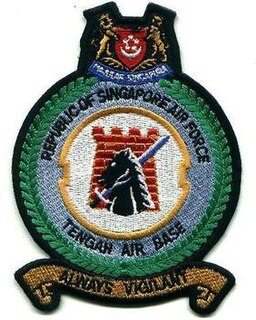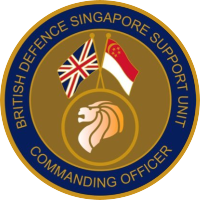
The British Aircraft Corporation (BAC) was a British aircraft manufacturer formed from the government-pressured merger of English Electric Aviation Ltd., Vickers-Armstrongs (Aircraft), the Bristol Aeroplane Company and Hunting Aircraft in 1960. Bristol, English Electric and Vickers became "parents" of BAC with shareholdings of 20%, 40% and 40% respectively. BAC in turn acquired the share capital of their aviation interests and 70% of Hunting Aircraft several months later.

The British Aircraft Corporation TSR-2 is a cancelled Cold War strike and reconnaissance aircraft developed by the British Aircraft Corporation (BAC) for the Royal Air Force (RAF) in the late 1950s and early 1960s. The TSR-2 was designed to penetrate a well-defended forward battle area at low altitudes and very high speeds, and then attack high-value targets in the rear with nuclear or conventional weapons. Another intended combat role was to provide high-altitude, high-speed stand-off, side-looking radar and photographic imagery and signals intelligence, aerial reconnaissance. Only one airframe flew and test flights and weight-rise during design indicated that the aircraft would be unable to meet its original stringent design specifications. The design specifications were reduced as the result of flight testing.

A variable-sweep wing, colloquially known as a "swing wing", is an airplane wing, or set of wings, that may be swept back and then returned to its original straight position during flight. It allows the aircraft's shape to be modified in flight, and is therefore an example of a variable-geometry aircraft.

RAF Akrotiri is a large Royal Air Force base on the Mediterranean island of Cyprus. It is located in the Western Sovereign Base Area, one of two areas which comprise Akrotiri and Dhekelia, a British Overseas Territory, administered as a Sovereign Base Area.

The Blackburn Buccaneer is a British carrier-capable attack aircraft designed in the 1950s for the Royal Navy (RN). Designed and initially produced by Blackburn Aircraft at Brough, it was later officially known as the Hawker Siddeley Buccaneer when Blackburn became a part of the Hawker Siddeley Group, but this name is rarely used.

Royal Air Force Coningsby or RAF Coningsby, is a Royal Air Force (RAF) station located 13.7 kilometres (8.5 mi) south-west of Horncastle, and 15.8 kilometres (9.8 mi) north-west of Boston, in the East Lindsey district of Lincolnshire, England. It is a Main Operating Base of the RAF and home to the Typhoon Force Headquarters and three front-line Eurofighter Typhoon FGR4 units, No. 3 Squadron, No. 11 Squadron and No. 12 Squadron. In support of front-line units, No. 29 Squadron is the Typhoon Operational Conversion Unit and No. 41 Squadron is the Typhoon Operational Evaluation Unit. Coningsby is also the home of the Battle of Britain Memorial Flight (BBMF) which operates a variety of historic RAF aircraft.

CVA-01 was a proposed United Kingdom aircraft carrier, designed during the 1960s. The ship was intended to be the first of a class that would replace all then-existing Royal Navy carriers, most of which had been designed before or during the Second World War. CVA-01 and CVA-02 was intended to replace HMS Victorious and HMS Ark Royal, while CVA-03 and CVA-04 would have replaced HMS Hermes and HMS Eagle respectively.

Tengah Air Base is a military airbase of the Republic of Singapore Air Force located in the Western Water Catchment, in the western part of Singapore. The station is the most important airfield of the RSAF as it houses the majority of the RSAF's fixed-wing frontline squadrons, home to all of RSAF's Airborne early warning and control (AEWC) assets, most of the F-16C/D Fighting Falcons and many UAVs. The airfield goes by the motto of Always Vigilant, which is supported by its main motif, a black knight chess piece symbolising the aircraft's operational readiness in Tengah. The sword represents war's heraldic sword of destruction, while the state is depicted by the castle.

East of Suez is used in British military and political discussions in reference to interests beyond the European theatre, and east of the Suez Canal, and may or may not include the Middle East. The phrase was popularized by Rudyard Kipling in his 1890 poem Mandalay. It later became a popular song when a tune was added by Oley Speaks in 1907.

Sembawang Air Base is a military airbase of the Republic of Singapore Air Force located at Sembawang, in the northern part of Singapore. The base motto is Dare and Will.
The history of the Royal Air Force, the air force of the United Kingdom, spans a century of British military aviation.

HMS Royalist was a Bellona-class light cruiser of the Royal Navy during the Second World War.

The General Service Medal, is a campaign medal of the United Kingdom introduced in 1962 to replace both the General Service Medal (1918), as awarded to the Army and RAF, and the Naval General Service Medal (1915). The 1962 GSM was awarded until 2007, when it was replaced by the Operational Service Medal. In 2015 the General Service Medal (2008) was introduced.

892 Naval Air Squadron was a carrier-based fighter squadron of the British Royal Navy's Fleet Air Arm. It was formed in 1943, flying Grumman Martlets, and was the only operational Fleet Air Arm squadron to fly the McDonnell Douglas Phantom FG.1.

The Singapore strategy was a naval defence policy of the British Empire that evolved in a series of war plans from 1919 to 1941. It aimed to deter aggression by the Empire of Japan by providing for a base for a fleet of the Royal Navy in the Far East, able to intercept and defeat a Japanese force heading south towards India or Australia. To be effective it required a well-equipped base; Singapore, at the eastern end of the Strait of Malacca, was chosen in 1919 as the location of this base; work continued on this naval base and its defences over the next two decades.

BAC/Dassault AFVG was a 1960s project for supersonic multi-role combat aircraft with a variable-sweep wing, jointly developed by British Aircraft Corporation in the United Kingdom and Dassault Aviation of France.
899 Naval Air Squadron was a squadron of the Fleet Air Arm of the United Kingdom.

The General Dynamics F-111K was a planned variant of the General Dynamics F-111 Aardvark medium-range interdictor and tactical strike aircraft by General Dynamics, to meet a requirement for such an aircraft for the Royal Air Force.

The United Kingdom operated the McDonnell Douglas F-4 Phantom II as one of its principal combat aircraft from 1968 to 1992. The UK was the first export customer for the Phantom, which was ordered in the context of political and economic difficulties around British designs for the roles that it eventually undertook. The Phantom was procured to serve in both the Royal Navy's Fleet Air Arm (FAA) and the Royal Air Force in several roles including air defence, close air support, low-level strike and tactical reconnaissance.

The British Defence Singapore Support Unit (BDSSU) is a British naval facility located in Sembawang, Singapore. A remnant of a larger naval base, known as HMNB Singapore, the facility provides fuel and other supplies to Royal Navy ships in the region, as well as those of other countries. It is the only permanent Royal Navy presence to remain at the former naval base, which is maintained by Naval Party 1022 under the auspices of the Five Power Defence Arrangements (FPDA).

















